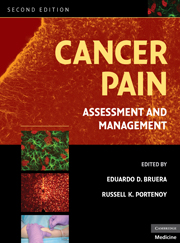Book contents
- Frontmatter
- Contents
- Contributors
- Preface
- SECTION I MECHANISMS AND EPIDEMIOLOGY
- SECTION II EPIDEMIOLOGY AND SYNDROMES
- SECTION III ASSESSMENT
- 5 The assessment of cancer pain: measurement strategy
- 6 Multidimensional assessment: pain and palliative care
- 7 Evaluating pain for children with cancer
- 8 Pain syndromes in cancer survivors
- SECTION IV PHARMACOLOGICAL TREATMENT
- SECTION V OTHER INTERVENTIONAL STRATEGIES
- SECTION VI REHABILITATION AND PSYCHOLOGICAL INTERVENTIONS
- SECTION VII THE ROLE OF ANTINEOPLASTIC THERAPIES IN PAIN CONTROL
- SECTION VIII PAIN IN SPECIAL POPULATIONS
- SECTION IX DIFFICULT PAIN PROBLEMS
- SECTION X SYSTEMS OF CARE
- Index
- Plate section
- References
8 - Pain syndromes in cancer survivors
from SECTION III - ASSESSMENT
Published online by Cambridge University Press: 06 July 2010
- Frontmatter
- Contents
- Contributors
- Preface
- SECTION I MECHANISMS AND EPIDEMIOLOGY
- SECTION II EPIDEMIOLOGY AND SYNDROMES
- SECTION III ASSESSMENT
- 5 The assessment of cancer pain: measurement strategy
- 6 Multidimensional assessment: pain and palliative care
- 7 Evaluating pain for children with cancer
- 8 Pain syndromes in cancer survivors
- SECTION IV PHARMACOLOGICAL TREATMENT
- SECTION V OTHER INTERVENTIONAL STRATEGIES
- SECTION VI REHABILITATION AND PSYCHOLOGICAL INTERVENTIONS
- SECTION VII THE ROLE OF ANTINEOPLASTIC THERAPIES IN PAIN CONTROL
- SECTION VIII PAIN IN SPECIAL POPULATIONS
- SECTION IX DIFFICULT PAIN PROBLEMS
- SECTION X SYSTEMS OF CARE
- Index
- Plate section
- References
Summary
Introduction
Over the past decades, aggressive therapies for cancer have led to improved statistics for long-term survival. From 1996 to 2002, the 5-year survival rate for all cancers was 66%, which represents a significant increase from 51% in the short span between 1975 to 1977. Although 5-year survival rates do not represent the numbers of patients who are cured from cancer, it is an indicator that many cancer patients are living longer. The actual numbers of cancer survivors in the U.S. populace remain unknown, but reported estimates are in the range of 10 million to 12 million. It is anticipated that life expectancies after a cancer diagnosis will continue to increase with new developments in cancer treatments. With increasingly aggressive therapies, survivors may face more residual problems that will ultimately affect their ongoing level of functioning, quality of life (QOL), and need for health care.
Limited research has been conducted on cancer survivors relative to the large numbers of studies of patients actively undergoing treatment for cancer. As such, it is impossible to obtain precise estimates of the number of survivors with chronic problems as a result of their disease or its treatment, such as pain. Issues related to cancer survivorship have recently been brought to the national forefront. The American Journal of Nursing and the National Cancer Institute sponsored a consensus conference in July 2005.
- Type
- Chapter
- Information
- Cancer PainAssessment and Management, pp. 145 - 164Publisher: Cambridge University PressPrint publication year: 2009



